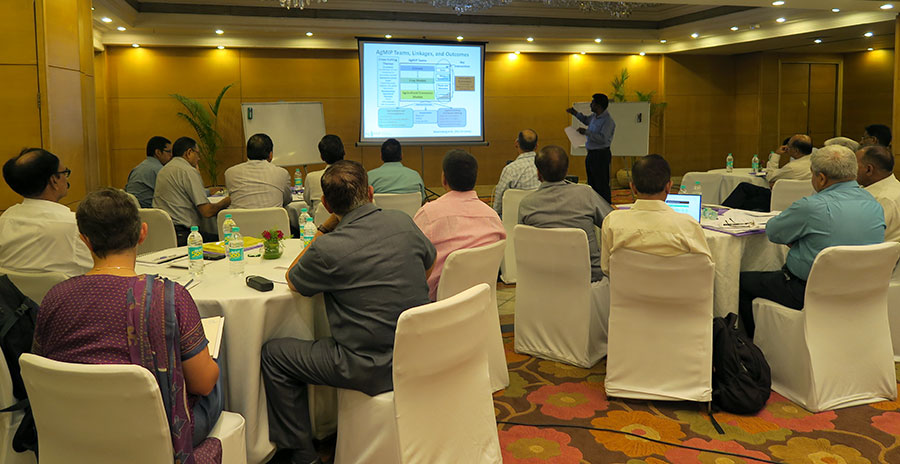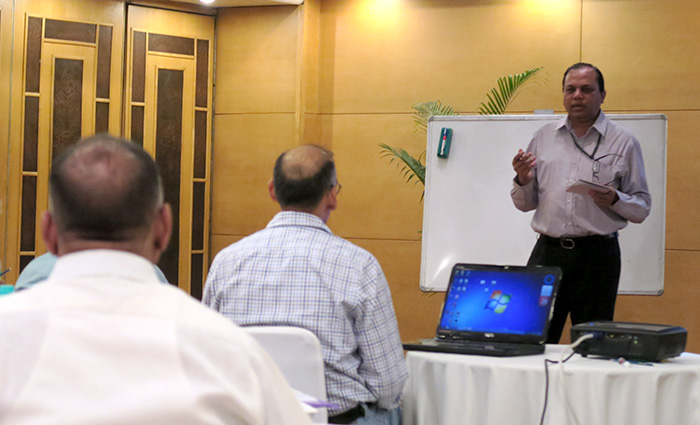By Nataraja Subash
On May 26th, 2016, a one-day National Level Technical Experts consultation meeting was hosted by the AgMIP South Asia Regional Research Teams (RRTs) from the Indo-Gangetic Basin (IGB) and Southern India (SI). The consultation meeting was held to initiate development of national level Representative Agricultural Pathways (RAPs 4 and RAPs 5) that are narratives and indicators used to project long-term agricultural changes in India.
Support for the meeting was provided by AgMIP and coordinated by AgMIP-IGB and ICRISAT. Logistic support was provided by ICRISAT, and the meeting was held at Hotel Jaypee Siddharth, New Delhi. It was the first meeting to establish national scale RAPs for India.

Participants listen to presentation by Dr. N. Subash, Principal Investigator of AgMIP Indo-Gangetic Basin Team.
Prior to this meeting, Representative Agricultural Pathways (RAPs), that use plausible farm-level improvements and socio-economic information to construct scenarios for input into agricultural models, were limited to specific regions in India. The high diversity of cropping systems found within India made RAPs transfer difficult. However, a national level RAP design would be advantageous to assist decision-makers with national planning. A primary goal of this meeting was to ensure that the All-India national RAP development remained consistent with the global and regional pathway frameworks AgMIP modelers have already undertaken.
The main objectives of the meeting were to document AgMIP National RAPs that will serve as a base for future research, understand the expectations of stakeholders from AgMIP research, discuss opportunities for integrating AgMIP results into national and regional decision-making, and explore the possibilities of a larger AgMIP-India program. The workshop also was an opportunity for stakeholder needs to be integrated into the AgMIP research and research gaps to be addressed and for stakeholders to become familiar with the AgMIP initiative.

Dr. S.K. Chaudhari, Assistant Director General, Soil and Water Management, ICAR, provides feedback pertaining to the indicators and drivers of RAPs
Participants of the workshop represented a wide variety of expertise. Technical experts from crop, water, socio-economic, extension, soil, and livestock disciplines participated. Members from the Indian Council of Agricultural Research, India Meteorological Department, State Agricultural Universities, the International Maize and Wheat Improvement Center (CIMMYT), and the International Water Management Institute were present. Dr. Amy Sullivan, Co-lead of Stakeholder Unit (SU) of AgMIP facilitated the discussion and Dr. Guillermo A. Baigorria, Assistant Professor and AgMIP resource person (ARP) of the IGB project also participated and contributed to fruitful and effective group discussions.
Dr. A. S. Panwar, Director of the ICAR-Indian Institute of Farming Systems Research, Modipuram, Meerut, began the meeting with a call to all participants to take stock of the RAPs narratives in Indian context. Principal Investigators Dr. N. Subash (IGB) and Dr. V. Geethalekshmi (SI), presented an introduction of AgMIP activities and the integrated assessment methodology. They highlighted how AgMIP activities differ from similar ongoing initiatives in the region, before discussing the short and long term goals of the meeting.
After project introductions, Dr. Roberto Valdivia presented the concepts of pathways and scenarios. Particular attention was drawn to the relevance these pathways and scenarios have on the development of national RAPs under sustainable and unsustainable growth scenarios. Following this presentation, Dr. Harbir Singh, Co-PI of the IGB-RRT project, explained the narratives and indicators under RAPs2. RAPs2 represents a business-as-usual scenario. This presentation highlighted what to expect for India’s agriculture in the years ahead if no actions to reduce carbon emissions are taken in the near future.
Dr. A.K. Sikka, Ex-DDG(NRM), ICAR and IWMI, India representative emphasized that the AgMIP protocols are very robust. The indicators selected to construct the RAPs are very likely to capture the realities to be experienced on the ground. Dr. Sikka noted that since the RAPs are intended for national scale, the current sample size is too small, and more coverage of the state is needed for meaningful results. He also emphasized that the variables selected for use in constructing the RAPs have different influence levels. For example, fertilizer and water have a greater impact on agricultural outputs than other variables and therefore should be prioritized in RAPs.
Dr. S.K. Chaudhari, ADG(SWM), NRM Division, ICAR highlighted that agriculture is a very complex system, there are many unknown and less pronounced factors that may impact the results. It is important for these factors to be assessed. As Dr. Chaudhari noted, fertilizers and subsidy components are primarily driven by socio-political settings. When modelling, these factors must be considered and handled cautiously. The AgMIP protocol and methodology to RAP development assists in managing these factors, as the farming system research approach helps strengthen the reliability of modelling results.
Following the first technical session, the participants formed two separate breakout groups: RAP4 (Green India) and RAP5 (Gray India), and participating stakeholders were asked to give feedback on the variables selected for these two RAPs. These two RAPs are designed to represent different pathways in which India may develop. RAP4, “Green India,” documents a more sustainable development pathway, in which there is a strong movement towards sustainable agricultural systems, environmental policies and technological changes. RAP 5, “Gray India,” documents a more environmentally degraded pathway, in which economic growth is prioritized, and there is less consideration for the environment.
The breakout session was very beneficial. Significantly, the stakeholders helped AgMIP scientists identify indicators including, but not limited to, market conditions and volatility, the cost of pest management, and cooperative farming, as significant indicators that should be incorporated into the RAP design. There was common agreement on the direction and magnitude for most of the indicators identified. This was particularly evident during post-breakout presentations, where open discussion was held for each indicator.
As a result of this workshop, AgMIP gained more visibility among decision makers and the scientific community. RAP initiatives progressed through stakeholder perspectives and inputs, and RAP development will be completed soon. New insights gained for this workshop will assist in increasing the focus of modelling work. The stakeholders attending the workshop agreed to contribute to the development of National RAPS through email/questionnaires. The meeting concluded with all voicing approval of the concept of All-India RAPs.

